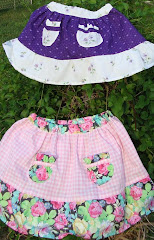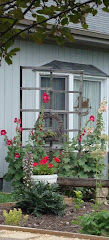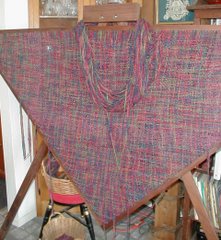 Pickled peppers are a pantry staple here. DH always plants several types of peppers and every year I put up quarts of hot banana peppers (aka Hungarian Wax?), and sometimes jalapeno or serrano peppers. Years ago I used to put up the sweet banana peppers, too, but DH has gone completely to the hot side in recent years and doesn't plant them anymore.
Pickled peppers are a pantry staple here. DH always plants several types of peppers and every year I put up quarts of hot banana peppers (aka Hungarian Wax?), and sometimes jalapeno or serrano peppers. Years ago I used to put up the sweet banana peppers, too, but DH has gone completely to the hot side in recent years and doesn't plant them anymore. This year after several years of me asking "why not plant pepperoncini, too?" he finally decided to take the plunge. (Which is a real good thing as I've not found pepperoncini to be readily available at our local farmer's market in previous years.) We've had a good crop so far and I'm on the third canning session for pepperoncini. The crockpot will get a workout this winter as we all like Italian beef sandwiches on hearty homemade wholegrain rolls. And, tho I've tried preparing the roast with hot banana peppers, I prefer the milder (to my taste anyway) pepperoncini peppers. (BTW, why is it every time I go to type that word I misspell it as pepperocini? Anyone else with that problem?)
I use the same recipe for pickling any of the hot peppers. It's very basic and easy to do. It's okay to combine different pepper varieties in the same jar, too. For heat distribution while processing, it might be best to stick with similar sizes of peppers, tho. These can also be sliced into rings before jarring but I find the texture is better if they're left whole then sliced before serving, if desired. If you've never canned before check out the latest Ball Blue Book of Preserving or the USDA-funded website, National Center for Home Food Preserving, for detailed directions.
Pickled Peppers
4 quarts peppers
1-1/2 cups salt (non-iodized or pickling salt recommended)
1 gallon plus 2 cups water, divided
2 cloves garlic
2 tablespoons prepared horseradish, optional
10 cups vinegar (5% acidity)
1/4 cup sugar
Wash peppers. Leave up to an inch of stem on each pepper. Cut two small slits in each pepper. (Wear plastic gloves to prevent burning hands.)
Dissolve salt in gallon of water. Put peppers in a large non-reactive container that will hold the peppers and the gallon of water. Pour salt water over peppers and put a dinner plate on top to hold peppers below level of water. May need to weight plate with a glass jar filled with water and capped. Let stand at room temperature for 12 to 18 hours.
Drain and rinse peppers, then drain thoroughly. Combine 2 cups water and remaining ingredients in large saucepan; simmer for 15 minutes. Remove garlic.
Pack peppers into hot sterilized canning jars, leaving 1/2-inch head space. Pour boiling hot pickling liquid over peppers, leaving 1/4-inch head space. Adjust lids.
Process half pints and pints for 10 minutes, quarts for 15 minutes in boiling water water.
 Oh, and the Pepperoncini Beef is a simple crockpot recipe. Put a beef chuck roast in the slow cooker. Pour liquid and pepperoncini from pint canning jar over roast and cook on Low for 6 to 8 hours. That's it. If peppers were canned in a quart-size jar, just put half the peppers and half the liquid over beef or use a larger roast and the whole quart. Original recipe based on a 2-1/2 to 3-pound roast. Venison works great, too. If you want to get fancy add garlic, onions or an Italian dressing seasoning packet along with the peppers and their pickling juice.
Oh, and the Pepperoncini Beef is a simple crockpot recipe. Put a beef chuck roast in the slow cooker. Pour liquid and pepperoncini from pint canning jar over roast and cook on Low for 6 to 8 hours. That's it. If peppers were canned in a quart-size jar, just put half the peppers and half the liquid over beef or use a larger roast and the whole quart. Original recipe based on a 2-1/2 to 3-pound roast. Venison works great, too. If you want to get fancy add garlic, onions or an Italian dressing seasoning packet along with the peppers and their pickling juice.
















































